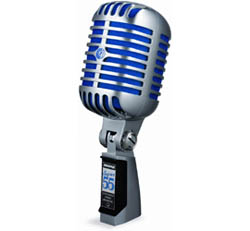
Roadworthy Condensers
In 1961, Sennheiser introduced MKH mics, using an RF condenser principle of operation. As explained by Walker, “With a regular condenser, you put 48 volts of DC across both plates, and as the front plate vibrates the capacitance changes. What Sennheiser did is to take this another step. Instead of using a DC voltage, we put a sine wave of 8 MHz across there.
“As the diaphragm moves,” he continues, “it actually creates an FM modulation, which is then decoded to audio right inside the microphone. Today we use AM, and using some better techniques, we get an even better signal than with FM.”
Born brings up the Shure SM81 pencil condenser—“the world’s first professional pre-polarized electret condenser mic”—introduced in the mid-1980s. He continues, “By professional, I mean it’s rugged enough to be used on stage and didn’t lose voltage over time.” Building upon this achievement, the dual-diaphragm KSM9 was the first switchable pattern handheld condenser mic designed for live performance.
A-T’s Gary Boss elaborates, “As PA fidelity increased, various sound engineers experimented with mics like our ATM4033 on stage, which was one of the first cost-effective side-address studio microphones—happening right around the birth of digital recording, ADATs, and so on. We responded to their needs for a roadworthy studio-quality mic with our dual large-diaphragm, multi-pattern ATM4050, which was a very pivotal mic on stage. It started to become a guitar cabinet and overhead mic of choice, being very rugged and under $1,000. You could pretty much use it on any tour.”
Earthworks has deep roots in measurement microphones, noted for their accuracy and wide frequency response. Engineering director Daniel Blackmer discusses how the hypercardioid, “high-definition” SR40V handheld condenser came into being. “Touring engineers began experimenting with our SR30 cardioid mic, with its measurement-mic form factor, for vocals, and asked if we could develop a rugged handheld with similar audio characteristics. After an intensive development process, along with field testing on critical tours, we were able to deliver a mic that exceeded their expectations and that we warranty for 15 years.“
Blackmer continues, “The main thing has actually been to get back to the true basics: to fully understand the acoustic impulse response, and what a true free field microphone actually is, and to design every product based on that philosophy. And to fully realize that the testing methods that are often accepted as “standard,” such as reciprocity calibration, have some very substantial drawbacks that are not properly acknowledged (such as relying heavily on mathematically modeling the coupler between the microphones diaphragms).
Earthworks has developed testing methods and apparatus that allow us to produce and test mics in the process of being assembled in such a way that we can maintain and tune each unit in a true free field condition, to see its actual behavior in the real world.“
Rounding out the condenser discussion, the form factor of the DPA d:facto II handheld mic has a creative innovation, such that the mic capsule can be quickly transferred from a wired handheld to a wireless format – allowing the same transducer to be used differently as the need arises. Product manager Mikkel Nymand notes that “we started all over with a new design that made it possible to use the same capsule for a wired, phantom-powered application as well as within adapters for the most commonly used wireless handles.”

